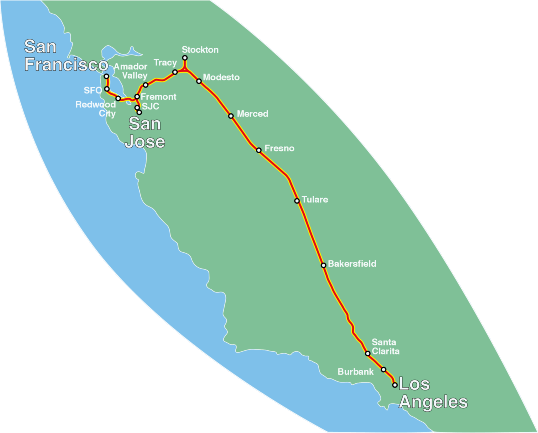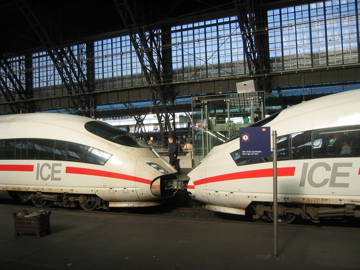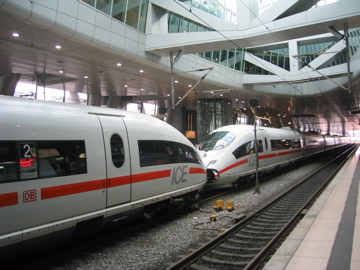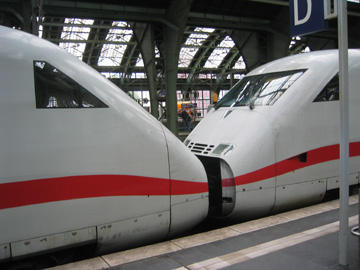

Possible phase one of the proposed
high speed rail system, if an Altamont Alignment is used.

| The proposed state bond for high speed rail will
only provide the state's share for the initial SF-LA system. After that
first phase is running, construction will begin on additional lines. The system will be more successful if the route for the intial system serves as many communities as possible, without sacrificing travel time between the Bay Area and Los Angeles. An Altamont Alignment serves well over a million more people than either alternative under consideration by the high speed rail authority. Consider the map above. There are 17 stations, including 4 in the northern San Joaquin Valley and two in the East Bay that would not be built if the Pacheco Alternative was chosen. Stations with Altamont:
One good indicator of construction cost for a high speed railway is the miles of tunnels that are required. Bored tunnels (to get through montains) are the most expensive type of construction. The three basic alternatives vary greatly in the miles of tunnels required to build the line:
 Critics of an Altamont alignment argue that service to the Bay Area would be compromised because of the need to serve terminals in both San Jose and San Francisco. How much would it cost to operate HSR between LA and SF/SJ using the Altamont 'split'? Operating costs are based on trainset-kms and number of operators. HSR to SF is projected by the CHSRA to have about double the demand of the LA link to SJ. Let's consider an HSR schedule that provides an equal number of arrivals and departures to SF and SJ, using twinned-trainsets (two trains coupled together) for the SF train and single trains for SJ. The CHSRA's ridership studies show a demand of about 19.5m trips per year for the Bay Area stations, or 32,500 boardings a day. Demand is roughly split 2:1 between Peninsula and South Bay stations. Assuming 400-person trains, or 800-person twinned trains, an equal number of trains could depart from each Bay Area terminal, under an Altamont scheme: Peninsula trains would be twinned, and South Bay trains would be single. Assuming 60% capacity, or 240
persons/train,
32,500 / 0.6 = 54,166 seats needed 54,166 seats needed / 400 seats per train = approx. 136 trains this would generate a demand for about 46 departures/day from each terminus. Trains originating in San Francisco would be twinned, single trains would serve the South Bay, for a total of 136 trainsets. (Twinned train = two trainsets coupled as one train) 136 trains / 3 trainsets =
approx. 46 train departures
each day from each Bay Area terminus If a southern alignment into the Bay Area was chosen, the demand would require about 68 twinned trains/day to the Bay Area, 54,166 seats/ 800 seats per
twinned train =
67.7 twinned trains or 75% of the total number of train departures/arrivals as in the Altamont scheme, but still 136 trainsets.  Los Angeles to San Francisco via a southern alignment (assumed Pacheco) is about 670km. Los Angeles to San Francisco via Altamont is about 677km. Los Angeles to San Jose is about 632km via Altamont. In the case of an Altamont alignment, there would be 92 trainsets operating to San Francisco each day, for 124,568 train-km round trip (arrivals from LA plus departures to LA). SF via Altamont = 677km x 46
departures x 2 trainsets/train x 2 (roundtrip)
= 124,568 train-km San Jose would account for 46 trains, or 58,144 train-km. Together, this results in a 182,712 train-km/day. SJ via Altamont = 632km x 46 departures x 1 trainset/train x 2 (roundtrip) = 58,144 train-km Total train-km/day for Altamont = SF + SJ = 182,712 train-km For a southern alignment, there would be 68 twinned-trains operating, 182,240 train-km/day. SF/SJ via Pacheco = 670km x 68
departures x 2 trainset/train x 2 (roundtrip) =
182,240 train-km Total train-km/day for Pacheco = 182,240 train-km Note that this yields a difference of less than 0.3% in total train-km to provide an equal number of departures and arrivals to each of the Bay Area's terminals.  Assuming that the trains operate 18 hours/day, this would be a departure or arrival of a HSR train every 8 minutes, a significant addition to Peninsula corridor rail traffic under the Pacheco routing. 68 trains / 18 hours =
3.77 train/hr =
1 departure every 15.8 minutes These HSR trains would pass through Palo Alto and Sunnyvale without stopping. With the Altamont routing, the trains would depart from San Jose every 23.5 minutes. The trains would not pass through Palo Alto or Sunnyvale or create attendant noise impacts in those cities without providing a direct transportation benefit. 46 trains / 18 hours =
2.56 train/hr =
1 departure every 23.5 minutes The difference in departure frequencies between these scenarios is not significant from a traveler's point of view given the distances traveled. Just as a traveler doesn't base a decision to fly from SFO instead of from SJC to LA based on the fact that the frequency of flights from SFO to LA is somewhat greater, neither will a traveler decide against riding HSR because of a slight difference in frequency or travel time. HSR trains would travel more frequently through Fremont under this scenario, as opposed to not at all. Fremont has the advantage that it would connect the HSR line to the BART system. BART could also connect to HSR in the Amador Valley. Cheaper Extension to Sacramento The difference between alignments is much greater for Phase two trains between the Bay Area and Sacramento. San Francisco to Sacramento via a southern alignment (assumed Pacheco) is about 484km, vs. 261km via Altamont. San Jose to Sacramento is 405km via Pacheco vs. 216km via Altamont. |
![]()